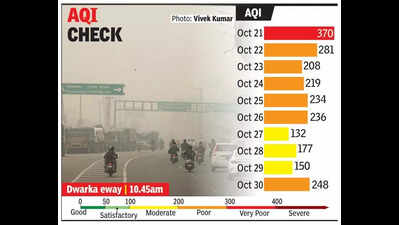Business
Gurgaon Suffers Poor Air Quality Amid Monitoring Failures

Gurgaon’s air quality has deteriorated significantly, with the Air Quality Index (AQI) reaching a troubling score of 248 on October 30, 2023, indicating a shift into the ‘poor’ category. This decline follows three days of moderate air quality, raising concerns as local emissions and pollution levels escalate. The situation is exacerbated by ongoing issues with air quality monitoring stations, which have been unreliable in recent days.
On Thursday, October 30, 12 out of the 32 continuous ambient air quality monitoring stations in Haryana failed to record data. This included two stations in Gurgaon—Teri Gram and Sector 51—as well as others in Faridabad, Ambala, Fatehabad, Hisar, Karnal, Nuh, Palwal, and Sirsa. The Yamunanagar station also reported either no data or was marked as “station offline.” Just a day earlier, on October 29, 20 of the 32 stations were non-operational, including three in Gurgaon.
The AQI readings demonstrate a concerning trend. On October 27, the AQI was recorded at 132, which increased to 177 on October 28, slightly dipped to 150 on October 29, and then surged to 248. This pattern typically emerges as temperatures drop and wind speeds decrease during the late October period. Notably, Gwalpahari recorded an alarming AQI of 319, categorised as ‘very poor,’ suggesting localized pollution levels could be even worse than the overall average of 248.
As November approaches, the National Capital Region (NCR) often experiences an accumulation of pollution due to several factors, including trapped emissions, increased vehicular traffic, construction dust, waste burning, and industrial activities.
Shubhansh Tiwari, a research associate at the Centre for Science and Environment, emphasized the importance of reliable monitoring data, stating, “Tackling winter pollution isn’t just about emergency responses once the air turns toxic. We need complete, reliable monitoring data to identify hotspots and act early. When half the stations go dark, we are not just losing numbers; we are losing time, public health safeguards, and accountability.”
Despite officials claiming that seasonal controls are in place, experts argue that insufficient monitoring hinders timely interventions and complicates targeted actions.
Forecasts from the India Meteorological Department (IMD) indicate mainly clear skies with temperatures having risen by 1-3°C in recent days. Although minimum temperatures remain above normal, cooler air layers are settling closer to the surface. Calm winds, only occasionally reaching 8-12 km/h, have not been effective in dispersing pollutants.
Looking ahead, the weather department predicts similar conditions, including the possibility of light rain in some areas and generally mild winds over the next two days. Minimum temperatures are expected to remain 1-2°C above normal before dropping again in early November. Unfortunately, conditions for dispersing air pollutants are anticipated to remain poor, with the mixing height expected to stay low around 500 meters.
The ventilation index values, which measure air quality dispersion potential, are reported to be below 6,000 m²/s on certain days, indicating a challenging situation for air quality management. Forecasts suggest that air quality in Gurgaon will likely remain in the ‘very poor’ category through at least the first week of November, underscoring the urgent need for improved monitoring and intervention strategies.
-

 World5 months ago
World5 months agoSBI Announces QIP Floor Price at ₹811.05 Per Share
-

 Lifestyle5 months ago
Lifestyle5 months agoCept Unveils ₹3.1 Crore Urban Mobility Plan for Sustainable Growth
-

 Science4 months ago
Science4 months agoNew Blood Group Discovered in South Indian Woman at Rotary Centre
-

 World5 months ago
World5 months agoTorrential Rains Cause Flash Flooding in New York and New Jersey
-

 Top Stories5 months ago
Top Stories5 months agoKonkani Cultural Organisation to Host Pearl Jubilee in Abu Dhabi
-

 Sports4 months ago
Sports4 months agoBroad Advocates for Bowling Change Ahead of Final Test Against India
-

 Science5 months ago
Science5 months agoNothing Headphone 1 Review: A Bold Contender in Audio Design
-

 Top Stories5 months ago
Top Stories5 months agoAir India Crash Investigation Highlights Boeing Fuel Switch Concerns
-

 Business5 months ago
Business5 months agoIndian Stock Market Rebounds: Sensex and Nifty Rise After Four-Day Decline
-

 Sports4 months ago
Sports4 months agoCristian Totti Retires at 19: Pressure of Fame Takes Toll
-

 Politics5 months ago
Politics5 months agoAbandoned Doberman Finds New Home After Journey to Prague
-

 Top Stories5 months ago
Top Stories5 months agoPatna Bank Manager Abhishek Varun Found Dead in Well









